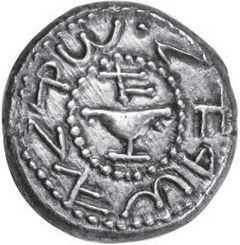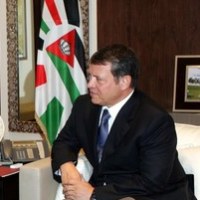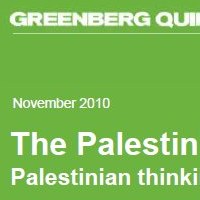![]()
Summer 2012 | Middle East Quarterly, Volume XIX: Number 3, pp. 15-22 | by Alexander H. Joffe
The Rhetoric of Nonsense
Fabricating Palestinian History
For nearly two decades the Palestinian Authority (PA) has been denying Israel’s right to exist, and a recent “Nakba Day” was no exception. In a Gaza speech on behalf of Mahmoud Abbas, his personal representative made the following statement:
National reconciliation [between Hamas and Fatah] is required in order to face Israel and Netanyahu. We say to him [Netanyahu], when he claims that they [Jews] have a historical right dating back to 3000 years B.C.E. — we say that the nation of Palestine upon the land of Canaan had a 7,000-year history B.C.E. This is the truth, which must be understood, and we have to note it, in order to say: “Netanyahu, you are incidental in history. We are the people of history. We are the owners of history.”[1]
This remarkable assertion has been almost completely ignored by the Western media. Yet it bears a thorough examination: not only as an indication of unwavering Palestinian rejection of Israel’s right to exist but as an insightful glimpse into the psyche of their willfully duped Western champions.
Unpacking Abbas’s Speech
Archaeologists have only the dimmest notion of prevailing ethnic concepts in 7000 B.C.E. There may have been tribes and clans of some sort, and villages may have had names and a sense of collective or local identity, but their nature is completely unknown. Even with the elaborate symbolism of the period, as seen in figurines, and other data such as the styles of stone tools and house plans, nothing whatsoever is known regarding the content of the makers’ identities. Writing would not be invented for almost another 4,000 years and would only reach the Levant a thousand years after that, bringing with it the ability to record a society’s own identity concepts.
There were no Jews or Arabs, Canaanites, Israelites, or Egyptians. There were only Neolithic farmers and herders. In fact, none of the concepts that Abbas used developed until vastly later. The Plst — a Mediterranean group known to the Egyptians as one of the “Sea Peoples” and who gave their name to the biblical Philistines — arrived around 1200 B.C.E. Arabs are known in Mesopotamian texts as residents of the Arabian Peninsula from around 900 B.C.E. The concept of a “nation” emerged with the kingdoms of Israel and Judah and their neighbors sometime after 900 B.C.E. The Romans renamed the Kingdom of Judea “Palestina” after the biblically attested Philistines, the hated enemy of the Israelites, following the defeat of the Bar Kochba revolt in 135 C.E. The ethnic identity called “Palestinian,” denoting the local Muslim and Christian inhabitants of the region south of Lebanon and West of the Jordan River, tenuously developed as an elite concept at the end of the Ottoman era and did not propagate to the grassroots until the 1920s and 1930s.[2]
Is there perhaps genetic continuity between modern Palestinians and Neolithic farmers and herders? Perhaps, but that is not what Abbas claimed. Is there cultural continuity, a nation with a name? Hardly.
Types of Palestinian Rhetoric
Why then should Abbas make such an incredible fabrication? And why lie in such a ludicrous and extravagant fashion? Part of the answer is that for Abbas, as it was for PLO leader Yasser Arafat before him, there is a reflex that simply and absolutely cannot accept the antiquity of Jews. Arafat famously told then-U.S. president Bill Clinton that there was no Jewish temple in Jerusalem, causing the usually unflappable Clinton to nearly explode.[3] Denials regarding the Jewish historical connection to the Land of Israel generally and categorical denials that Jews constitute a nation are all frequently heard from Palestinian leaders, intellectuals, and others.

Denials regarding the historical Jewish connection to the Land of Israel are frequently heard from Palestinian leaders, intellectuals, and others. U.S. president Bill Clinton (right) nearly exploded in outrage when Yasser Arafat (middle) told him that there was no Jewish temple in Jerusalem.
A useful avenue of investigation is to consider Abbas’s words as a type of rhetoric with a form and underlying philosophy. When viewed in this way, Abbas’s spokesman was not lying as such but doing something else.
As philosopher Harry Frankfurt put it
The fact about himself that the bullshitter hides … is that the truth-values of his statements are of no central interest to him; what we are not to understand is that his intention is neither to report the truth nor to conceal it … A person who lies is thereby responding to the truth, and he is to that extent respectful of it … For the bullshitter, however, all these bets are off: He is neither on the side of the true nor on the side of the false. His eye is not on the facts at all, as the eyes of the honest man and of the liar are, except insofar as they may be pertinent to his interest in getting away with what he says. He does not care whether the things he says describe reality correctly. He just picks them out, or makes them up, to suit his purpose.[4]
As Frankfurt describes it, such nonsensical rhetoric is constructed impulsively and without thought — entirely out of whole cloth. It is unconcerned with truth and so, unlike a lie, has license to be panoramic, unconcerned with context. The user is endeavoring to bluff, and the desire for effect is paramount. Whereas lying is austere and rigorous because it must triangulate against truth, nonsense loses, and loosens, the grasp on reality. In that sense, its effect is corrosive, a matter not discussed by Frankfurt.
Stating nonsense to suit one’s purpose is only one of three obvious Palestinian rhetorical strategies. Lying, knowingly distorting the truth, is another. A paradigmatic example of this is “Pallywood,” the staging of scenes for news cameras. These have ranged from orchestrated street scenes and rioting, which sometimes include fake casualties who leap off of stretchers when out of sight, to destroyed structures and grieving families, to manipulated photographs. Above all there was the so-called Jenin massacre of 2002 and the Muhammad al-Dura case in 2000. In the former, Palestinians accused Israelis of having killed hundreds or thousands of civilians and bulldozing their bodies into mass graves, deliberate lies that were then repeated by human rights organizations. In fact, some fifty-two Palestinian gunmen and twenty-three Israeli soldiers were killed in brutal house to house fighting.[5]

Stating nonsense to suit one's purpose is only one Palestinian rhetorical strategy. Knowingly distorting the truth is another. An example of this is "Pallywood," the staging of scenes for news cameras. This photograph was widely distributed with the observers cropped out and promoted as a picture of an Israel Defense Forces soldier stomping on a Palestinian child. The uniform is not an IDF uniform; the boots are not IDF boots, and the weapon (AK-47) is not one used by the IDF. This picture was actually taken in Bahrain 2009 during a street theater performance.
In the Dura case, a Palestinian stringer for French television purported to have observed a Palestinian father and son caught in a firefight in Gaza, during the course of which the boy appeared to have been killed. The iconic martyrdom and funeral of the boy became an international symbol of Israeli brutality. But examination of withheld footage showed other Palestinian “wounded” getting up and walking around and contained no death throes of the Dura boy. In fact, grave doubts exist whether a boy died at all in the exchange and whether his father was injured. A series of lawsuits have not resolved the situation, but the impact of what is at least in large part a fabrication is clear.[6] As French journalist Catherine Nay wrote with satisfaction, Dura’s supposed death “cancels, erases that of the Jewish child, his hands in the air before the SS in the Warsaw Ghetto.”[7] This statement holds the key to understanding the reception of Palestinian rhetoric in Europe. It is a means to erode historical and moral realities regarding the European treatment of the Jews, and it is eagerly embraced in some quarters.
The third Palestinian approach is to propagandize through the lens of pure ideology, specifically Islam. Thus, for example, the former Jerusalem mufti and chairman of the Supreme Islamic Council in Jerusalem, Ekrima Sabri, was recently quoted as saying “after twenty-five years of digging, archaeologists are unanimous that not a single stone has been found related to Jerusalem’s alleged Jewish history.” This statement is patently false, but the orientation of the religious lens is obvious, indeed, he goes on to state clearly: “We do not recognize any change to the status of Jerusalem, and we reserve our religious, historic, geographic, and cultural heritage in the city, no matter how long or how many generations succeed.”[8] Islamic doctrine as it has evolved today simply cannot accept the reality of the Jewish connection to Jerusalem precisely on religious grounds. Sabri is, therefore, neither lying nor fabricating reality to suit his purposes but rather expressing what he regards as a true religious belief. This works in concert with lies and nonsense.
Swallowing Palestinian Rhetoric
Palestinian efforts to minimize or expunge Jews from history go back several decades but have intensified in recent years. Palestinian intellectuals make their own important contributions: Hayel Sanduqa recently claimed that the expression in Psalm 137:5, “If I forget thee, oh Jerusalem, may my right hand forget its skill” was authored by a Crusader king and stolen by “Zionists.”[9]
Palestinian denial of any Jewish connections to Israel and allegations that Israel is “Judaizing” Jerusalem are so routine as to be unheard by Israelis, accustomed as they are to Palestinian leaders blustering, lying, and simply making things up, from trivial allegations regarding Israeli “libido-increasing chewing gum” distributed in Gaza[10] to heinous allegations of all manner of war crimes. This is unfortunate since such claims of “Judaization,” largely by means of archaeological excavations and infrastructure modernization, featured for decades in international forums such as UNESCO,[11] are central to the global efforts to delegitimize Israel by elevating the Islamic status of Jerusalem.[12]

Palestinians will often ignore archeological findings in order to maintain their fabrications. The recent auction of this Judean shekel coin from 66 C.E., bearing the Hebrew words “Shekel of Israel (Year) 1 (of the Jewish rebellion against Rome)” was described in the official Palestinian Authority daily al-Hayat al-Jadida as “an ancient Palestinian coin” and “part of the Palestinian cultural heritage.”
By and large, the lack of Arab media attention suggests that they also take Palestinian claims with a heaping teaspoon of salt. In the absence of open warfare between Israel and the Palestinians, Arab media today appear preoccupied with more important events in Syria, Egypt, Iran, and elsewhere. Even so, why has there been so little attention to Abbas’s statement?
The Palestinian reception of rhetoric such as Abbas’s is a critical question. Palestinian nationalist rhetoric since the early 1920s was characterized by what even Palestinian-American historian Rashid Khalidi has called “overheated prose.”[13] From the beginning, it was also suffused with local, pan-Arab and Islamic themes that were sometimes complementary but often in tension with one another. In general, Palestinian rhetoric today takes place in an environment that has been progressively Islamized over the past two decades by Arafat and the Palestine Liberation Organization (PLO), in part through competition with Hamas and other Islamist and jihadist movements.[14] Islamic themes and imagery have helped frame and elaborate political discourse and in turn have intensified the Islamic dimension of Palestinian collective identity.[15]
While a full study of language and cognition in Palestinian culture is beyond the scope of this article, it is useful to bear in mind the analysis of Arab societies as “high context” cultures. In such cultures, the domination of in-groups with similar experiences and expectations requires fewer but more carefully selected words that convey complex messages using inferences supplied by the listener. By contrast, communications in “low context” cultures are not aimed at in-groups and, therefore, tend to be more explicit.[16]
Seen in this light, Palestinian political statements regarding their Neolithic origins and continuity, which can be regarded in historical, rhetorical, and philosophical terms as completely fictional, might be understood as simply innovative shorthand communications to an in-group. On the one hand, it nominally cites Western scientific frameworks, which demonstrates a sort of modernist orientation. But on the other, the emotive power and real intention is largely supplied by the listener, who hears in effect that Palestinians have existed forever, along with the implication that this fact is supported by history or even science.
Together with lies and ideological speech, fictional nonsense helps shape Palestinian culture, beliefs, and political behavior. To say that this is at odds with objective reality as recovered by science is to miss the point. To some unknowable but large degree, this is Palestinian reality. What from the outside appears to be disjointed and nonsensical bits in reality are seamless parts of a larger Palestinian whole, beliefs about the history, the world, culture, and the self. The question then becomes the relationship of that reality to others. And here the matter of media as a conduit and interpreter becomes paramount.
The problem is that in-group statements and the reality they create are never restricted to the in-group. Western reception of rhetorical nonsense varies widely. Western media have been silent about the Neolithic Palestinian nation, and this is most instructive. The simplest explanation why Abbas’s comments were not mentioned in Western press accounts is that literal nonsense from Palestinians simply does not register. Although it is not acknowledged, to some extent Palestinian nonsense is likely recognized as such by Western media and filtered out, at least semiconsciously, as “overheated prose.” Ironically, of course, objections to such cultural stereotyping are characteristic of the Orientalist critique although they are rarely made when such analyses come from Arab sources.
Willing Infidels
What Israelis regard as incitement — rhetoric designed to inflame populations and move them to hatred and violence — thus seems to register as mere epiphenomena to other Western audiences, who appear to seek a simple, moralistic tale with materialist underpinnings. By and large, Western media in particular, abetted by intellectuals, have created a singular distortion zone around “Israel/Palestine” — turning it into a clear-cut morality tale of colonial white people with F-16s oppressing indigenous brown people with stones and the odd suicide bomber.
A recent study of how the Arab-Israeli conflict is treated by the Reuters news agency noted the pervasive use of appeals to pity and to poverty, innuendo, euphemisms and loaded words, multiple standards and asymmetrical definitions, card-stacking, symbolic fictions, and atrocity propaganda, along with non-sequiturs and red herrings. The study concludes that “Reuters engages in systematically biased storytelling in favor of the Arabs/Palestinians and is able to influence audience affective behavior and motivate direct action along the same trajectory.”[17]
For most journalists engaged with the moralistic narrative, fantastic stories about Palestinians having existed 9,000 years ago do not even rise to the level of cognitive dissonance; it is, for now, nonsense discourse and anti-realism. But another factor for the lack of Western attention to such statements is found in Frankfurt’s discourse on nonsensical rhetoric; the sincerity of the user cannot be challenged since to do so would require making fundamental judgments. To preserve the fiction of rational interlocutors, sincerity must be accepted as a token of trustworthiness even as the simple words of the statement contradict such claims.
Three other factors also play a role: the postmodern downgrading of objectivity and the idea of a single shared reality; the elevation of multiple narratives as being equally valid, and the valuation of feelings over facts. Challenging rhetorical nonsense, in addition to potentially compromising journalistic access, could hurt interlocutors’ feelings.
There is more than a little condescension at work in the Western reception of these strategies if not actual contempt. For one thing, Palestinians lies and nonsense are rarely challenged by the media or other interpreters besides those termed Israel advocates, something that has itself been transformed into a negative semantic and social category. It is almost as if Palestinians are expected simply to make things up as they go along, which then may or may not be accepted by the West according to how well they fit the Palestinian narrative.
Ideological religious statements are similarly ignored but in all likelihood for different reasons. Non-religious Western observers simply have no intellectual framework to interpret such strong statements outside materialist constructs that regard religion generally as epiphenomenal or false consciousness. For these reasons, the Islamic rather than nationalistic basis for the Arab-Israeli conflict has been systematically downplayed from the 1930s. Even the Hamas charter — which is nothing but forthright regarding its religious basis, theological anti-Semitism, and calls for genocide — is largely excluded from journalistic and even academic analyses because it makes no sense within the context of frameworks that are exclusively nationalistic and materialist in nature.

Part of the reason Western supporters are willing to go along with Palestinian historical revisionism is to compensate for European guilt over past behavior toward the Jews. For example, French journalist Catherine Nay wrote regarding the alleged Muhammad al-Dura killing that the boy’s death “cancels, erases that of the Jewish child, his hands in the air before the SS in the Warsaw Ghetto.”
But the eagerness with which certain lies are accepted, such as talk of Israeli war crimes, and the flimsy nature of Western journalistic investigations strongly shows that at least two additional levels of bias are at work. At one level, the narrative of the oppressed underdog is so strong that there is little inclination to press for truths that would undermine that narrative, embarrass the Palestinians, and in doing so, incur their wrath and limit the media access they give to their territories, sources, and stories. At the deeper level, as perfectly illustrated by the quote from Catherine Nay above, there is a deep need to find Israelis guilty in order to relieve Holocaust guilt (and, one might argue cynically, to get back to old-fashioned anti-Semitism) particularly among European descendents of its perpetrators. The satisfaction of making this so is palpable.
These factors also illustrate how the Palestinian narrative, even with ludicrous bits thrown in and others excluded, is arguably not by or even about the Palestinians. It is propelled largely by Western needs to see the world through the post-colonial lens of noble indigenes and evil Western colonists. The Palestinians may in fact have lost exclusive control of the narrative decades ago, perhaps as far back as the 1920s or 1930s, when their cause was taken over by the Arab states and the Muslim world. A more comprehensive view of the Palestinian narrative would see them as secondary contributors to a process propelled by Arab and Muslim states and refracted through Western media and universities, ultimately minor subjects in a far larger discussion between Islam and the West.
The problem is that, thanks to mindless parroting by journalists and human rights organizations of Palestinian lies and nonsense, hatred, anti-Semitism, and ceaseless incitement are gradually overwhelming the filters against anti-realism, particularly in Europe where there are powerful cultural incentives to think ill of Jews and wish ill for Israelis. The effects of this process are seen even more clearly throughout the Arab and Muslim worlds where, though free of Jews, anti-Semitism is all-pervasive.
Conclusion
An example of the erosion of Western critical filters was the unchallenged appearance of an opinion piece in The Washington Post in December 2011 that effectively repeated some of Abbas’s absurd statements regarding the antiquity of the Palestinians. Maen Rashid Areikat, the PLO representative to the United Nations, stated that Palestinians had “lived under the rule of a plethora of empires: the Canaanites, Egyptians, Philistines, Israelites, Persians, Greeks, Crusaders, Mongols, Ottomans, and finally, the British.” Throwing history out the window, he added
we are Arabs with black, brown, and white skin, dark- and light-colored eyes, and the whole gamut of hair types. Like Americans, we are a hybrid of peoples defined by one overarching identity. Many in the United States forget that Palestinians are Muslims and Christians. They ignore the fact that Palestinian Christians are the descendants of Jesus and guardians of the cradle of Christianity.[18]
Palestinians can simultaneously be Arabs, who arrived in the Levant in the seventh century C.E., and be more ancient than the Canaanites. At the same time, the empires they endured and that infused them include everyone except Arab ones, notably the Umayyad and Abbasid, which brought Arabs and Islam to the region in the first place. The fact-checkers of The Washington Post editorial page fall mute and shared reality is eroded further. Unfortunately this sort of rhetorical nonsense resonates deeply, especially with some Christian supersessionists committed to anti-Zionism.[19] History no longer matters.
It is often stated that peace can only come when Israelis and Palestinians recognize one another’s narratives. Claims regarding the Neolithic Palestinian nation indicate this unlikely to occur either in the future or in the past. In the meantime, anti-reality continues to spread.
Alex Joffe is a New York-based writer on history and international affairs. His web site is alexanderjoffe.net.
![]()
Footnotes:
[1] Palestinian TV (Fatah), May 14, 2011.
[2] Louis H. Feldman, “Some Observations on the Name of Palestine,” Hebrew Union College Annual, 61 (1990): 1-23.
[3] “Camp David and After: An Exchange, An Interview with Ehud Barak,” The New York Review of Books, June 13, 2001.
[4] Harry Frankfurt, On Bullshit (Princeton: Princeton University Press, 2005), p. 56.
[5] See the essays in Hersh Goodman and Jonathan Cummings, eds., The Battle of Jenin: A Case Study in Israel’s Communications Strategy (Tel Aviv: Tel Aviv University, Jaffee Center for Strategic Studies, 2003).
[6] Philippe Karsenty, “We Need to Expose the Muhammad al-Dura Hoax,” Middle East Quarterly, Fall 2008, pp. 57-65; Nidra Poller, “The Muhammad al-Dura Hoax and Other Myths Revived,” Middle East Quarterly, Fall 2011, pp. 71-8.
[7] Ivan Rioufol, “Les médias, pouvoir intouchable?” Le Figaro (Paris), June 13, 2008.
[8] Ahlul Bayt News Agency (Qom, Iran), June 23, 2011.
[9] Palestinian TV (Fatah), June 2, 2011, at Palestinian Media Watch, accessed Mar. 1, 2012.
[10] YNet News (Tel Aviv), July 13, 2009.
[11] See, for example, the summary in Craig Larkin and Michael Dumper, “UNESCO and Jerusalem: Constraints, Challenges and Opportunities,” Jerusalem Quarterly, Autumn 2009, pp. 16-28.
[12] Yitzhak Reiter, Jerusalem and Its Role in Islamic Solidarity (New York: Palgrave Macmillan, 2008), pp. 70-149.
[13] Rashid Khalidi, Palestinian Identity: The Construction of Modern National Consciousness (New York: Columbia University Press, 2009), p. 258, n. 76.
[14] Hillel Frisch, “Nationalizing a Universal Text: The Quran in Arafat’s Rhetoric,” Middle Eastern Studies, May 2005, pp. 321-36.
[15] Mahmoud Mi’ari, “Transformation of Collective Identity in Palestine,” Journal of Asian and African Studies, Dec. 2009, pp. 579-98.
[16] Rhonda S. Zaharna, “Understanding Cultural Preferences of Arab Communications Patterns,” Public Relations Review, 21 (1995): 241-55.
[17] Henry I. Silverman, “Reuters: Principles of Trust or Propaganda?” Journal of Applied Business Research, Nov./Dec. 2011, pp. 93-116.
[18] Maen Rashid Areikat, “Palestine, a history rich and deep,” The Washington Post, Dec. 27, 2011.
[19] David Wenkel, “Palestinians, Jebusites, and Evangelicals,” Middle East Quarterly, Summer 2007, pp. 49-56.



 RSS
RSS










Latest Comments
Hello Mike, Thank you for your positive feedback to the article. I felt there wasn’t too much critical analysis of ...
Thanks for this considered and well constructed article. A follow up article on the manner in which the editorial contro...
THE CLUELESSNESS OF CLAIMING THAT OBAMA'S MIDDLE EAST POLICIES WERE A FAILURE CANNOT BE FURTHER FROM THE TRUTH, WHAT THE...
As long as Obama is the president of the usa do not trust the us government......
Thank you for an good read....